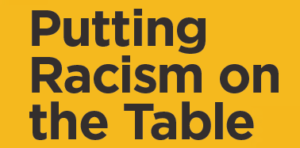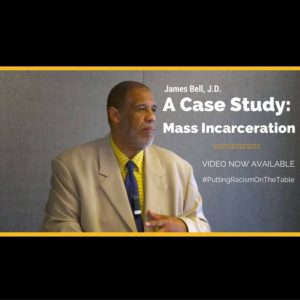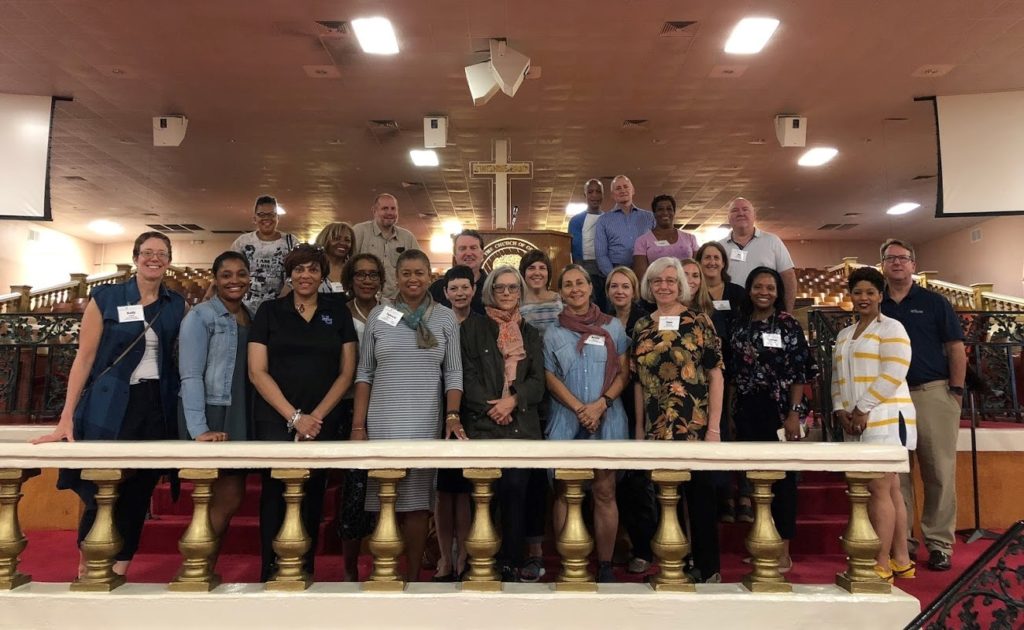
Putting Racism on the Table
Putting Racism on the Table
When grantmakers in the Washington, DC area grappled with the national scourge of police-involved killings, they found something much deeper: A model for philanthropists to understand racism and work for racial justice.
It started soon after the death of Freddie Gray.
Not the civil unrest that ensued in neighborhoods in Baltimore, Maryland, but the elevated racial consciousness that emerged within the philanthropic community in Washington, DC.
Philanthropic leaders here wondered if they should support neighboring Baltimore or work to lessen the likelihood of such an event occurring in their own community. It was 2015. Cell phone videos of other police-involved incidents across the country were the backdrop. Everyone knew that it wasn’t just Freddie Gray, but also Michael Brown and Tamir Rice, Eric Garner, Walter Scott, Sandra Bland, and other African American victims. As foundation leaders began to dissect the situation in Baltimore within the context of these other deaths, topics of race, racism, and bias emerged side-by-side with issues of poor housing, poor schools, and poor health care.
What was new to the conversation, surprisingly, was the overlay of race. This was a significantly different conversation for the members of the Washington Regional Association of Grantmakers (WRAG), and a bit of a treacherous one.  Those who attended the first meeting to discuss a response and possible next steps were comfortable talking about affordable housing, teacher preparation, and gang violence. They had discussed these topics and many others innumerable times, but race itself had been taboo. Now, these philanthropists—black and white, mostly women—were acknowledging that race and racism may have been a major factor in the death of Freddie Gray and the unrest that followed in his city.
Those who attended the first meeting to discuss a response and possible next steps were comfortable talking about affordable housing, teacher preparation, and gang violence. They had discussed these topics and many others innumerable times, but race itself had been taboo. Now, these philanthropists—black and white, mostly women—were acknowledging that race and racism may have been a major factor in the death of Freddie Gray and the unrest that followed in his city.
The conversation stopped when one participant acknowledged a true lack of knowledge, not just about how racism and bias may have played a part in these events, but about racism and bias—period. The group members didn’t know much about what they were trying to discuss. They had a sense of it, but at no time in their professional lives or academic training had they sought to learn deeply or been taught about race and racism. A quote from John Gardner, the founder of Common Cause and the Independent Sector, was mentioned casually by one participant. It resonated and became the framing for everything that followed:
“The first step in leadership is not action, it’s understanding.”
Seeking Understanding Together
From that comment was born a year-long initiative boldly labeled “Putting Racism on the Table.” Organized and hosted by WRAG, it started as a series of six learning opportunities for philanthropic CEOs and trustees, once a month, for six months. The first three sessions focused on topics: structural racism, white privilege, and implicit bias. The next meeting explored a case study to show how those factors presented in one system (mass incarceration), followed by a review of the racial mosaic of America.  The series ended with a session on the role of philanthropy in addressing racism and racial inequity. Each three-hour session began with a lecture by a nationally-known expert on the topic, followed by a conversation, all facilitated by the same person chosen for her adeptness at leading deep conversations on race.
The series ended with a session on the role of philanthropy in addressing racism and racial inequity. Each three-hour session began with a lecture by a nationally-known expert on the topic, followed by a conversation, all facilitated by the same person chosen for her adeptness at leading deep conversations on race.
After the learning series, there were five more training sessions: on grantmaking with a racial equity lens, on communicating about race; and a concluding session asking what this philanthropic community would do because of what they had learned over an exceptionally focused year. Participants called the initiative “transformational,” “thought-provoking,” and “eye-opening.”
Many participants acknowledged that without this deep dive into structural racism and implicit bias, they would have continued to focus on symptoms without understanding causality.
Exactly what had been revealed? What in the thinking of these philanthropists, individuals committed to addressing the needs of their community, had been transformed? And, how had their approach to grantmaking been altered by their learning experience?
I offer two examples. Together, we learned that mass incarceration is the result of structural racism, white privilege and implicit bias in the criminal justice system. We started with a historical perspective, considering the consequences of slavery, followed by a host of racialized laws and practices that criminalized everyday behaviors and prevented African Americans from obtaining the skills and opportunities to rise, continuing their subservience to the prevailing white, economic system. Combine that historical reality with an understanding that some crimes have been penalized differently (possession of cocaine vs. crack is a classic example), and that prisons have developed into economic engines for small, rural communities, and you may begin to see mass incarceration differently. With this insight, what explains the disproportionate number of African Americans in the U.S. criminal justice system? Are they inherently more criminal or are they victims of a system that has criminalized them?

During a “civil rights learning journey” in 2018, Washington-area grantmakers and other leaders visit the 16th Street Baptist Church in Birmingham, Alabama, site of a 1963 bombing that marked a turning point in the civil rights movement. Credit: Washington Regional Association of Grantmakers.
Or, consider the education system. We explored how starting as early as preschool, black children, particularly boys, are disciplined for “acting out.” At the same time, black girls are disciplined for being “disrespectful” and perceived as “less innocent” than their white counterparts. Even at this young age, black children are suspended disproportionately from school. Is bias at play? Are teachers perceiving, perhaps unconsciously, normal behavior on the part of black children as being negative, even violent? Studies suggest that this is the case. Unless you have been made aware of this possibility, your focus as a funder remains on “fixing” these boys and girls when the true need is to “fix” the biases and prejudices held by teachers and school administrators.
Making Equity a Grantmaking Priority
Without the formal, structured learning series offered by “Putting Racism on the Table,” the local philanthropic community would not have looked deeply into the historical, psychological, and policy realities that contribute to the social ills they are trying to address. Many participants acknowledged that without this deep dive into structural racism and implicit bias, they would have continued to focus on symptoms without understanding causality. Learning together as a philanthropic community gave the experience a credibility and offered participants a critical support network.

Participants also visit Mason Temple in Memphis, where Martin Luther King, Jr. delivered his seminal “I’ve Been to the Mountaintop” speech in 1968, the day before his assassination. Credit: Washington Regional Association of Grantmakers.
Over the past two years, funders have continued to develop a deeper appreciation for the pervasiveness and impact of racial bias. In WRAG’s annual check-in with members, one year after the series, roughly a third reported that they were applying a racial equity lens to their grantmaking, and thirty percent were seeking additional learning and training opportunities for their staff and leadership around racial equity. Two years after the program, the progress continues: More than half of the funders are talking with their grantees about racial equity. Many more are seeking additional learning opportunities or changing their grantmaking priorities and practices—including, for example, setting aside dedicated funding to support this portfolio—based on a greater understanding of how they can work for racial equity. The importance of the collective learning experience remains, as a third of the WRAG membership are participating in learning and action via WRAG’s Racial Equity Working Group.
This progress now extends beyond the local philanthropy community. Leadership Greater Washington (LGW), a well-respected association of high-level, cross-sector leaders in the region, reached out to WRAG to broaden their understanding of this issue. Together, in 2018, WRAG and LGW hosted another six-month learning initiative. This time called “Expanding the Table for Racial Equity,” it culminated in September in a trip to Tennessee, Mississippi, and Alabama, locales at the core of the civil rights movement. This experience strengthened participants’ understanding of the history of racial struggles and their connection to current racial reality in our country.
Today, in the Greater Washington region, there is a growing group of philanthropists that have been joined by elected officials, nonprofit, and business leaders in recognizing the depth, breadth, and impact of racism. They acknowledge the legacy of slavery, of Jim Crow policies, of the unfulfilled promise of the 1954 Supreme Court decision that separate was indeed not equal. They know that as a society, we have not legislated or mandated our way to equity, nor taken the time to understand how we got here. Until that occurs the path to equity remains unclear. But, they have taken important first steps. By putting racism on the table, they have acknowledged a wound and a reality. Now, they are working toward necessary policy change and racial healing.
Tamara Lucas Copeland is president of the Washington Regional Association of Grantmakers. For more information on Putting Racism on the Table, visit www.puttingracismonthetable.org or to learn more about Tamara’s personal journey toward racial equity, follow her blog, www.DaughtersOfTheDream.org.


